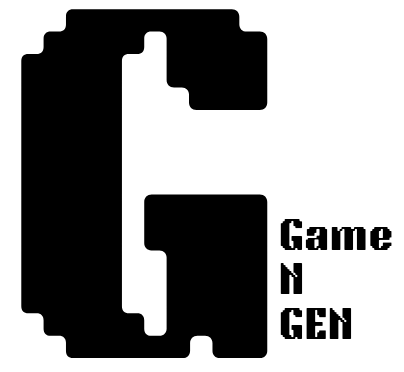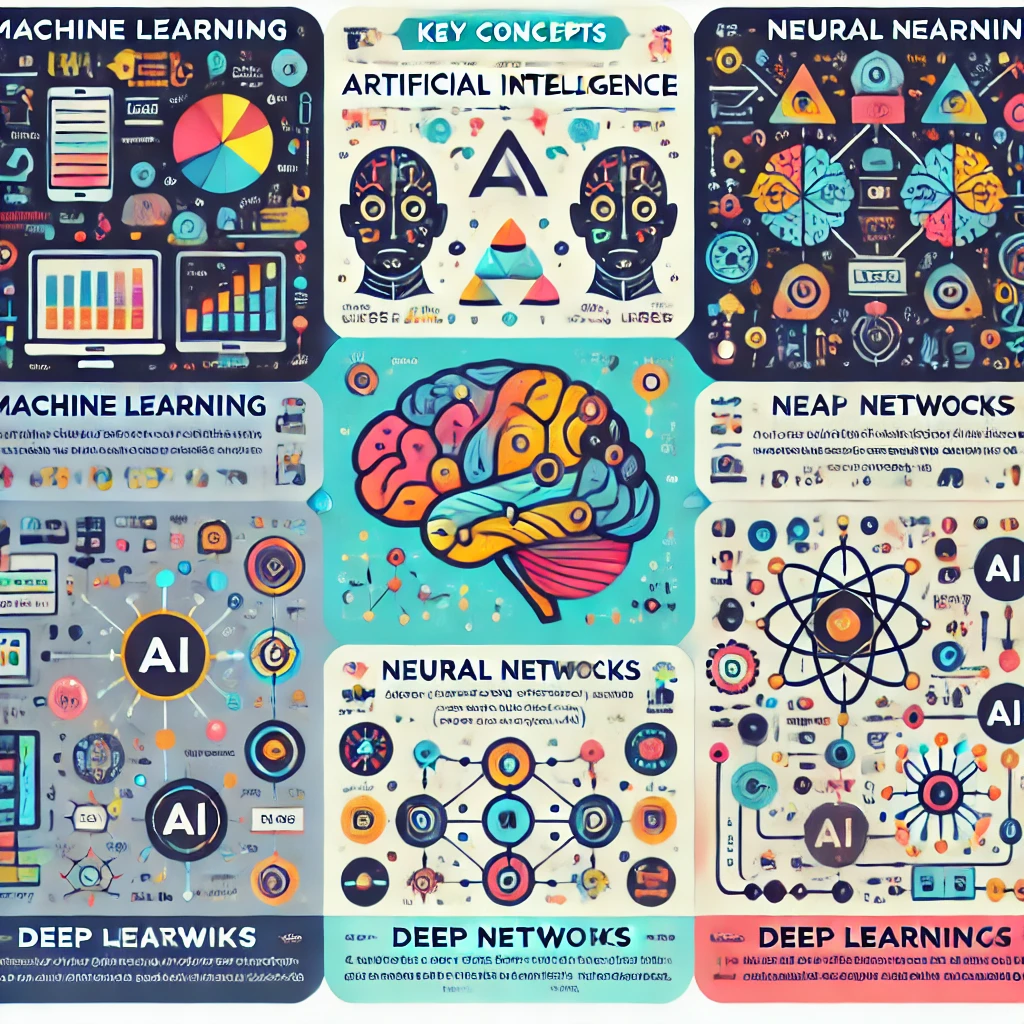Artificial Intelligence (AI) is rapidly changing our world. From personalized recommendations to self-driving cars, AI is everywhere. In this guide, we’ll explore some key AI concepts like Machine Learning, Neural Networks, Deep Learning, and Generative AI (focus keywords). These technologies are what make AI powerful and versatile, allowing it to solve complex problems in creative ways.
| # | Concept | Definition | Uses | Skills Required |
|---|---|---|---|---|
| 1 | Artificial Intelligence | The simulation of human intelligence processes by machines, especially computers. | Chatbots, personal assistants, autonomous vehicles, recommendation systems. | Basic programming, logical reasoning, knowledge of data structures and algorithms. |
| 2 | Machine Learning | Algorithms that allow computers to learn from data and improve from experience. | Spam filtering, recommendation engines, fraud detection, predictive maintenance. | Statistics, linear algebra, Python/R programming, data preprocessing, Scikit-Learn, TensorFlow. |
| 3 | Reinforcement Learning | Learning by taking actions in an environment to maximize cumulative reward. | Robotics, gaming AI, self-driving cars, dynamic pricing. | Probability theory, Markov decision processes, Python, TensorFlow, PyTorch. |
| 4 | Speech Recognition | The process of converting spoken language into text. | Virtual assistants, transcription services, voice-activated controls. | Natural language processing (NLP), signal processing, Python, deep learning frameworks. |
| 5 | Emergent Behavior | Unintended complex behaviors arising from simple rules in AI systems. | AI strategy games, swarm intelligence, robotics. | Complex systems theory, knowledge of multi-agent systems, Python. |
| 6 | Unsupervised Learning | A type of ML where a model finds patterns in unlabeled data. | Customer segmentation, anomaly detection, recommendation systems. | Clustering algorithms, Python/R programming, data visualization tools, Scikit-Learn. |
| 7 | K-Means | An unsupervised learning algorithm used for clustering data. | Market segmentation, pattern recognition, clustering search results. | Linear algebra, Python, Scikit-Learn, data visualization. |
| 8 | Supervised Learning | A type of ML where a model learns from labeled data. | Email classification, face recognition, predictive analytics. | Python/R programming, statistics, Scikit-Learn, data preprocessing. |
| 9 | Logistic Regression | A statistical model used for binary classification. | Predicting disease outcomes, spam classification, credit risk analysis. | Probability, linear algebra, Python, Scikit-Learn. |
| 10 | Linear Regression | A method for predicting a continuous output based on input features. | Stock price prediction, sales forecasting, trend analysis. | Linear algebra, statistics, Python/R programming, Scikit-Learn. |
| 11 | K-Nearest Neighbors (KNN) | A supervised learning algorithm that classifies data based on closest neighbors. | Image classification, recommendation systems, anomaly detection. | Understanding of distance metrics, Python, Scikit-Learn. |
| 12 | PCA (Principal Component Analysis) | A dimensionality reduction technique that simplifies data. | Data visualization, noise reduction, feature extraction. | Linear algebra, data preprocessing, Python, Scikit-Learn. |
| 13 | Neural Networks | Computing systems inspired by the structure of the human brain. | Image recognition, voice recognition, natural language processing (NLP). | Calculus, linear algebra, Python, TensorFlow, PyTorch. |
| 14 | Perceptron | The simplest type of artificial neural network, a single-layer binary classifier. | Basic image recognition, handwritten digit classification. | Linear algebra, Python, NumPy. |
| 15 | Backpropagation | A training method for neural networks using error correction to adjust weights. | Optimization of deep learning models, improving accuracy in classification tasks. | Calculus, Python, TensorFlow, PyTorch. |
| 16 | Feed Forward | A type of neural network where information moves in one direction only. | Pattern recognition, face detection, language modeling. | Linear algebra, Python, TensorFlow, PyTorch. |
| 17 | Hopfield Network | A type of recurrent neural network that stores memory patterns. | Pattern storage, associative memory tasks. | Knowledge of recurrent networks, Python, optimization techniques. |
| 18 | Support Vector Machines (SVM) | A supervised learning model used for classification and regression analysis. | Face detection, bioinformatics, text classification. | Linear algebra, optimization, Python, Scikit-Learn. |
| 19 | Decision Trees | A decision support tool that uses a tree-like model of decisions and consequences. | Medical diagnosis, financial analysis, customer relationship management (CRM). | Python, Scikit-Learn, data preprocessing, decision analysis. |
| 20 | Liquid State Machines | A type of neural network with temporal data processing capabilities. | Time-series prediction, spatiotemporal processing, dynamic pattern recognition. | Understanding spiking neural networks, Python, TensorFlow. |
| 21 | Self-Organizing Maps | A type of artificial neural network used for unsupervised learning. | Data clustering, pattern recognition, visualization of high-dimensional data. | Python, unsupervised learning techniques, data visualization. |
| 22 | Deep Learning | A subset of ML that uses neural networks with many layers to learn from large datasets. | Speech recognition, natural language processing, image classification. | Calculus, linear algebra, Python, TensorFlow, PyTorch, deep learning frameworks. |
| 23 | Deep Reinforcement Learning | Combines deep learning and reinforcement learning to solve complex decision-making tasks. | Robotics, gaming AI, autonomous vehicles. | Reinforcement learning, neural networks, Python, TensorFlow, PyTorch. |
| 24 | LSTM (Long Short-Term Memory) | A type of RNN capable of learning order dependence in sequence prediction problems. | Speech recognition, time series prediction, language modeling. | Recurrent neural networks, Python, TensorFlow, PyTorch. |
| 25 | Transformers | Neural network architecture designed for handling sequential data like text. | Machine translation, text summarization, question answering. | Attention mechanisms, Python, TensorFlow, PyTorch, NLP. |
| 26 | Epochs | The number of times the learning algorithm processes the entire training dataset. | Training deep learning models to minimize error and optimize performance. | Deep learning frameworks, Python, data preprocessing, optimization techniques. |
| 27 | Autoencoders | A type of neural network used to learn efficient data codings in an unsupervised manner. | Image denoising, dimensionality reduction, anomaly detection. | Neural networks, Python, TensorFlow, PyTorch. |
| 28 | Boltzmann Machine | A type of stochastic recurrent neural network used for optimization problems. | Feature learning, solving combinatorial optimization problems. | Knowledge of stochastic processes, Python, TensorFlow. |
| 29 | Deep Belief Network | A type of generative neural network with multiple layers of hidden units. | Feature extraction, unsupervised learning, dimensionality reduction. | Neural networks, Python, deep learning frameworks, TensorFlow. |
| 30 | Generative AI | AI that can generate new content like text, images, or audio. | Chatbots, image generation, content creation, music composition. | Neural networks, GANs, Python, TensorFlow, PyTorch. |
| 31 | RNN (Recurrent Neural Network) | A type of neural network that is suitable for sequence data. | Time series forecasting, natural language processing, handwriting recognition. | Recurrent networks, Python, TensorFlow, PyTorch. |
| 32 | CNN (Convolutional Neural Network) | A type of neural network designed to process grid-like data, especially images. | Image recognition, video analysis, medical image analysis. | Convolution operations, Python, TensorFlow, PyTorch. |
| 33 | GANs (Generative Adversarial Networks) | A model consisting of two networks competing to generate new, synthetic data. | Image synthesis, style transfer, data augmentation. | Neural networks, Python, TensorFlow, PyTorch, creative AI techniques. |
| 34 | N-shot Learning | A type of learning where the model learns effectively with a very small amount of data. | Image recognition with limited data, few-shot classification tasks. | Few-shot learning algorithms, Python, TensorFlow, PyTorch. |
| 35 | Transfer Learning | Using a pre-trained model on a new, similar task to reduce training time and data. | Medical imaging analysis, natural language processing, facial recognition. | Pre-trained models, Python, TensorFlow, PyTorch, deep learning. |
| 36 | Large Language Models (LLM) | Models trained on vast amounts of text to generate coherent language outputs. | Chatbots, summarization, translation, question answering. | Natural language processing, Python, Transformer models, attention mechanisms. |
| 37 | GPT (Generative Pre-trained Transformer) | An LLM trained to generate human-like text based on input prompts. | Text generation, content writing, chatbots, code completion. | NLP, Python, Transformer models, TensorFlow, PyTorch. |
| 38 | Agents | Autonomous entities capable of perceiving the environment and making decisions. | Robotics, virtual assistants, automated trading systems. | Reinforcement learning, Python, decision-making algorithms. |
| 39 | Multimodal AI | AI systems that can process and generate multiple types of data, such as text and images. | Conversational agents, content analysis, human-computer interaction. | Python, deep learning, data fusion techniques, TensorFlow. |
| 40 | RLHF (Reinforcement Learning with Human Feedback) | A combination of reinforcement learning and human feedback for improving AI. | Fine-tuning large language models, enhancing response quality in conversational AI. | Reinforcement learning, Python, human interaction knowledge, TensorFlow. |
| 41 | ZSL (Zero-Shot Learning) | The ability of a model to correctly predict classes it has not been explicitly trained on. | Recognizing unseen objects, text classification, semantic segmentation. | Semantic knowledge representation, Python, TensorFlow, PyTorch. |
| 42 | Q-LoRA | A fine-tuning method for quantized large language models, improving efficiency. | Efficient fine-tuning of LLMs, real-time model adaptation. | Quantization techniques, Python, TensorFlow, PyTorch. |
| 43 | BigGAN | A type of GAN architecture used for generating high-quality images. | High-resolution image generation, creative art design, video content creation. | GANs, Python, TensorFlow, PyTorch, deep learning. |
| 44 | OSL (One-Shot Learning) | Learning from just a single example to recognize or classify new objects. | Face recognition, rare class prediction, anomaly detection. | Few-shot learning techniques, Python, deep learning, TensorFlow. |
| 45 | Foundation Model | A large model trained on broad data at scale, adaptable to various tasks. | Language understanding, transfer learning, multi-domain AI applications. | Deep learning, Python, TensorFlow, large-scale model training. |
Machine Learning (ML) is a branch of AI where machines learn from data without being explicitly programmed. It includes methods like supervised and unsupervised learning, helping computers recognize patterns and make predictions. Imagine spam filters that can automatically identify unwanted emails. This is possible thanks to ML algorithms.
Neural Networks are computer systems designed to mimic how the human brain works. They are capable of learning from examples, just like a person would. For instance, they can be trained to recognize faces in a photo. With layers of neurons working together, neural networks are the backbone of Deep Learning, which is a specialized subset of ML. Deep Learning allows computers to analyze massive amounts of data to understand complex relationships, leading to improvements in tasks like image recognition and natural language processing.
Another exciting area in AI is Generative AI. This type of AI can create content—such as writing articles, generating art, or even composing music. Generative Adversarial Networks (GANs) are an example of this technology, which can generate images that look incredibly real. Generative AI is being used by artists, content creators, and developers to create new, innovative products that were unimaginable just a few years ago.
In conclusion, understanding these key AI concepts is essential to grasp how Artificial Intelligence is changing industries. Whether it’s machine learning for predictive analytics or generative AI for creativity, these technologies have a major impact on how we interact with machines in our daily lives. Remember, AI isn’t just a buzzword—it’s a collection of incredible technologies shaping the future., (and) driving innovation like never before.
If you’re looking to learn more about AI and its many applications, be sure to explore topics like Deep Learning, Machine Learning, and Neural Networks further to gain a deeper understanding.

